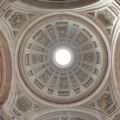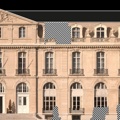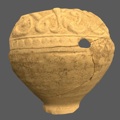


The main purpose of the protocols developed within the context of Tapenade project is to describe precisely the different acquisition and processing strategies that can be used to generate the 3D point cloud of any artifact. They are written chronologically, from the photographic acquisition to the final result.
Even if the main principles of a photographic acquisition are constant from one kind of artifact to the next, the shooting conditions can change according to their morphology, the constraints due to their environment, the purpose of the mission, etc. That is why the following documents are classified by kind of artifact, so the user can easily and effectually carry out a photographic survey, concentrating on the subject he wants to model.
The main principles of a terrestrial photographic acquisition are:
. Analysis of the site context
The analysis of the site context relates to the lighting conditions and the presence of obstructions (obstacles, vegetation, moving objects, urban traffic, etc.). The former influences the shooting strategy and the exposure values, the latter is essential in order to perform multiple acquisitions and the select the correct camera focal length. The choice of focal lengths has a direct influence on the number of acquisitions and the resolution of the final point cloud.
. Camera calibration
To correctly survey and model a scene, it is essential to employ geometrically calibrated cameras. Although the developed algorithms and methodology can perform self-calibration (i.e. on-the-field camera calibration), it is always better to accurately calibrate the camera using a 3D object / scene (e.g. lab testfield or building’s corner) following the basic photogrammetric rules: a dozen of convergent images at different distances from the object, with orthogonal roll angles and covering the entire image format. Each objective and focal length employed in the field must be calibrated
Façades
This protocol is about the generation of façades orthophotographies from 3D point clouds, stemming from a photographic survey. It is based on the missions conducted to the Estoublon Castle (Fontvieille, France), to the Pharo Palace (Marseille) and to Fontains Church.
Indoor spaces
This protocol concerns the creation of 3D point clouds of indoor spaces, with the aim of generating 3D models and orthophotographies. It is based on three different survey series: Saint-Jean Church (Marseille), Imperial Church (Ajaccio) and Philippe le Bel Tour (Villeneuve-les-Avignon).
Architecture
Archaeology
Architectural elements
This protocol describes the acquisition of architectural elements (columns, statues, etc.). It is based on the mission leaded from December 1st to 8 2010, to the Saint-Michel-de-Cuxa abbey (Codalet, France).




























Fig.1: an example of photos used for a self-calibration
Fig.2: paralllel images used for global orientation
Fig.3: multi-stereo images used for correlation
. Multi-stereo correlation for point cloud generation
In order to produce dense 3D point cloud of the surveyed scene, a master image for a certain area of interest must be generally selected. The master image is the central image of the multi-stereo configuration and it plays a central role in the image processing. Point clouds are generated according to the master image orientation and for each 3D point a RGB attribute is assigned.

master image
vertical stereo images
horizontal stereo image
Fig.4: principle of a multi-stereo acquisition
All the following documents were written as a synthesis of the observations made during different missions.
. Image acquisition and orientation
This phase aims to acquire all the images necessary for the 3D reconstruction of the surveyed scene. The overlap between the images should be around 80% in order to ensure adequate automatic detection of homologous points for the image orientation. The shooting configuration can be convergent, parallel or divergent. Convergent acquisitions ensure to image possible hidden details. If a detail is seen in at two images, then it can be reconstructed in 3D. It is also important to keep a reasonable base-to-depth (B/D) ratio: too small baselines guarantee more success of the automatic procedures but strongly decrease the accuracy of the final reconstruction. The number of images necessary for the entire survey depends essentially on the dimensions, shape and morphology of the studied scene and the employed focal length (for interiors fish-eye lenses are very appropriate).



Fragments
This protocol is about ceramic fragments. Because of their small size, the acquisition of these objects involves a lot of constraints during the shooting, that need to define a spefic acquisition method.




